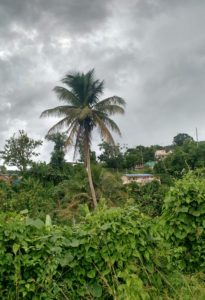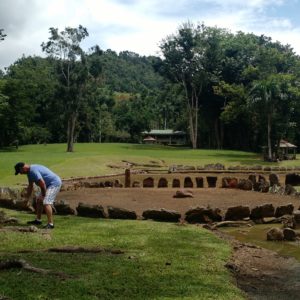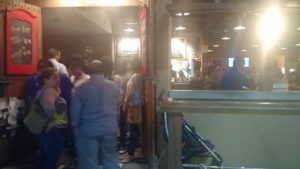
Caguana Indian Ceremonial Park
The indigenous people occupying Puerto Rico when Columbus arrived were a culture whose language similarities suggest they were related to the Arawak (Arhuaco) tribes of South America, specifically those from the Orinoco River delta in eastern Venezuela. They called themselves the “Taino” (meaning: relatives), possibly to distinguish themselves from other Carribean tribes. It was widely thought that the Taino were wiped out from Spanish colonization and it’s accompanying woes of disease and murder. However, the discovery of a 1,000 year old tooth in a Carribean cave led to DNA sequencing and the ability to detect this genetic evidence in modern day populations. The largest amount of Taino DNA today is found in those of Puerto Rican descent. Thanks to the magic of Ancestry.com we discovered that Don’s genetic make up contains Taino DNA. (Why wasn’t this information available to me when my kids were applying to colleges? I would’ve been checking the ‘Native American’ box on every application!) We are headed to the Parque Ceremonial Indigena de Caguana (Caguana Indian Ceremonial Park) to explore what’s referred to as the foremost archeological site in the Carribean.

From the drive up the mountains in Utuado.
The park is located in Utuado, a city in the central mountainous area of Puerto Rico. It’s a scenic 1 hr 45 min drive (give or take) from San Juan. It was an area hit particularly hard by Hurrican Maria as one of it’s main bridges was washed away leaving a portion of the citizenry unable to access food or other necessities. They wound up constructing a makeshift zip line to bring in supplies and transport people. When we arrived at the park after a hair-raising ascent up a mountain with a narrow 2-way road and many hairpin turns (Fortunately, the road to Rancho Russo shares most of these traits) we were acquainted with our guide, Michael. Born in Manhattan and a graduate of Bronx High School of Science, Michael decided to move to his ancestral home after serving in the U. S. Army. His grandmother gave him a piece of her land and he built his house by hand under the supervision of his uncle. He lives close by and although most of the locals like him have generators and cisterns for water collection after the hurricane they could not get any gas and what was available was being sold at $20 per liter. They need the generators to power their water filtration systems so potable water became an issue. Power was restored to their community 45 days after the storm. There is still no land line for telephone at the Park. They rely on cell phone service. After our museum visit and tour we sat in a bohio (recreated Taino shade structure) and spoke with Michael for over an hour while he told us the story of how the Park came to be and what challenges face the citizens of Puerto Rico today. He was a delightful conversationalist and we only left because it appeared that the sky was about to open up and unleash a torrential downpour.

Michael & friends at the Park.
The story goes that this land was privately owned and often the owner would go out into the fields and try to plow his farmland. He kept hitting and uncovering rocks that had carvings on them. When the U.S. acquired Puerto Rico after the Spanish American War a team of anthropologists and archeologists was dispatched to conduct a survey in 1914-1915. The scientists were on horseback in the area of Caguana and were talking with the locals and were told that they might be interested in talking to the guy who kept finding these weird rocks in his field. They visited the farmer who agreed to allow them to explore. Initially, Dr John Alden Mason would describe and map his findings but it was years later before serious excavations led to the discovery of 10 intact ceremonial plazas. The Puerto Rican government took over the property in 1957. Today the complex contains a Visitor’s Center, picnic area and the plazas. It is estimated that this site is over 800 years old.

A silk cotton tree – native to Africa and brought to the Carribean.

Don exploring the plazas
Around the perimeter of the site is a mountain formation called a cemi. It looks like 3 mounds lined up together. It is speculated that the Taino may have considered this geographical feature a representation of their deities related to fertility,healing and communication with the spiritual world and may be why this site was chosen by them. The plazas are ringed by stones containing petroglyphs (prehistoric rock carvings) with the largest plaza containing the largest stones. It is believed that the plazas were actually fields used to play ball. These batayes would see 2 teams compete in a game where they tossed a ball to players who couldn’t let the ball hit the ground. The spaces between the large fields may have been used for ceremonial dances, religious rituals and astronomical observation. It is believed the rocks were from the Tanama River which is adjacent to the site.

Petroglyphs
The amazing thing is that you can actually touch the stones and it’s like reaching back through time. The place definitely emits an energy that is palpable. (Even Don who thinks all that stuff is nonsense felt it.) The park was just recently named a National Historic Landmark (1993) and for many years vandalism and theft claimed many artifacts. Interestingly, today the Taino decendents are not a federally recognized tribal community so they are not granted any input into maintaining the site as a sacred tribal grounds despite the relatively recent use of DNA to show they are indeed alive & well. Our drive back to San Juan was a rainy one, as the clouds did burst but fortunately we were on the highway when that occured as opposed to the serpentine mountain road we had to negotiate on our descent from the park.
We decided that our last night in Puerto Rico we would spend doing a ‘progressive’ dinner where we would have drinks and appetizers as one establishment then dinner at another and then coffee and dessert at another. Our first stop was a Cuban themed restaurant and while I enjoyed a mojito and an appetizer sampler we had a very interesting discussion with Michael, our server, about his dreams and aspirations being a young person today in Puerto Rico. Michael has no desire to leave Puerto Rico despite the economic woes facing the population today, He is a very personable hustler who works several jobs while completing his on line education. I love talking to the locals.

What to have on a sultry night in Puerto Rico.

Photo courtesy of Michael
Our next stop was a burger place unimaginatively named, “The Place”. An interesting choice for me since 1. I don’t usually eat meat & 2. I never eat ground meat out. It was a weeknight and there was a line to get in and the place was packed so naturally we were curious. They were advertising an extended ‘happy hour’ and were serving $2 Coronas so we figured we’d a least grab a couple of those. They obviously were not expecting this sized crowd as it took a while for our server, Will, to get over to us. I asked him was The Place always this crowded on a Thursday night? He informed me that they were hosting some type of fundraiser for a local school (the place was full of families with middle school aged kids and younger). He then correctly assumed that we had never been there before and gave us the low down about the restaurant which has an extensive menu but the build your own burger thing is like their speciality. (A scan of the neighboring tables did show us some excellent looking burgers.) As a wise friend once pointed out to me when I ordered fish in a rib joint and got food poisoning, “When you’re in a rib joint, order ribs. When you’re in a steak joint, order steak.” I now live by this rule so we ordered burgers. They were massive, juicy and delicious. (Note to self: When you don’t normally eat meat, especially greasy hamburger, and you will be spending a large portion of time the next day confined to airports and airplanes you should probably order a salad.)

The Place
We were so full after our brews and burgers that our progressive dinner came to a halt. Fortunately, we had a lovely walk on a sultry night to head back to our hotel where we concluded the evening by making yet another donation to the casino. The next day, which was our departure day, we were able to have an extended check out which afforded us only 2 hours before our car was coming to take us to the airport. We did a little last minute shopping and then as we vacated our room we decided to head to the beachside restaurant to have lunch. It was extremely windy but sunny as a tropical storm was expected to pass by the southern portion of the island the next day. A quick check of the flight status revealed that there were no problems as we were departing from the northern side of the island. Every one of the locals we encountered in Puerto Rico wanted to make it very clear that tourism in Puerto Rico is very much open for business and they look forward to your arrival.

Adios Puerto Rico!

 Follow
Follow